Consider This Post Your “Craigslist Hacks Master Class” for Buying Good Stuff Cheap (& Selling it For $$$)
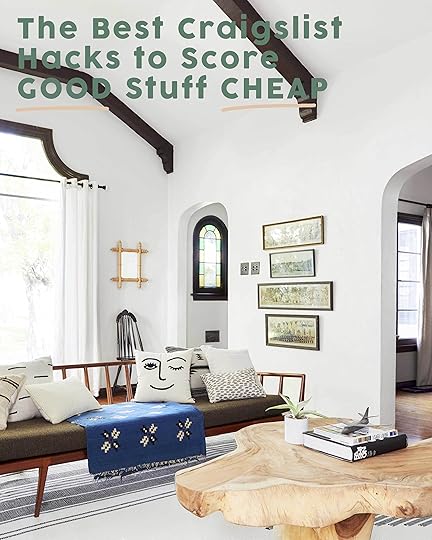

In a recent team hang out session, we found out that Caitlin, our Partnerships Director, has had a side business/hustle buying and selling furniture for years and when we prodded, which we do, she threw down knowledge that left us all writing resignation letters to EHD to explore this gamble. But I accepted no such letters and instead asked her to write a post with all her secrets and tips on how she actually MADE MONEY from this hoarder’s game. Caitlin, please educate these readers in the ways of the side hustle:
Welcome to the LAZY PERSON’s guide to starting a successful furniture side hustle, complete with all my best tips for getting the best stuff for the least amount of money and offloading it with almost no work at all. There are some people who can find a dresser on the side of the road, drag it home, refinish it, and sell it for a profit. I am not one of them. My garage is a museum of unfinished DIYs full of intent and regret (and thus shame). If you’re like me—you know, the kind of person who greatly overestimates both their general crafting ability and their capacity for physical labor—sit tight, because I got you.
I’m coming in hot with my top lessons I learned about sourcing very affordable vintage in great condition WITHOUT leaving your house (yes, it’s possible).
But real quick: How do I even know what I’m talking about? I started side hustling in 2016 with ONE RUG (that whole saga is detailed down at the bottom) and kept it up for 3 years…basically ’til I started working here at EHD! During this time, I un-retired from competitive figure skating while launching a startup (maybe proof that I’m not as lazy as I claim?) and somehow managed to pay my $2,200-month travel and training bills without accruing a lifetime of debt. Full disclosure: I know there’s not a ton of detailed posts online about starting something like this (trust me, I searched for one while I was figuring out my own best practices!) and I also know that my method is definitely not standard…but it worked without a ton of upfront investment (if any!) and so I’m just here to spread the word that like, hey. This is an option for you, too.
SO, over the past four years, I’ve survived hundreds of Craigslist meetups, back alley warehouse pickups, and precarious drives across Southern California with tables strapped to the top of my Subaru Legacy (photo proof below). I walked so y’all could run. (And also not like, waste a ton of money in the process…because hey, I’ve been there.)
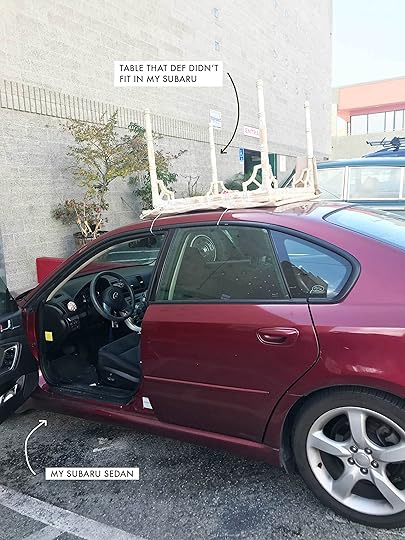
How to Source (i.e. Buying the GOOD Stuff for CHEAP)
These tips are good for EVERYONE, whether you’re looking to buy stuff for yourself, or to sell for profit, FYI. Anyway, you know how your local vintage store finds a majority of their stock? Estate sales and auctions. You know who doesn’t always have the time or money to compete with a vintage store in an estate sale or auction? Me.
If you live in a market outside of a major city, consider yourself lucky (and you get your cute lil’ butt to your local auction house, scoop up all the goodies, and open a Chairish shop, like, immediately!); the rest of us are settling down for a quick overview on…
Craigslist Best Practices
I’m proud to tell everyone that not even Emily knew some of these, so read on for the TOP SECRET goods that only someone who did this for a legit living (sort of) would learn along the way.
Tip 1: Master the “presets.” Open up a new tab right now, hit “For Sale” (you never know what goodies are hiding in “general,” “garage sale,” or “antiques”), then pound in your new presets on the left: “owner,” “has image,” “bundle duplicates,” and…the holy grail, “include nearby areas.”
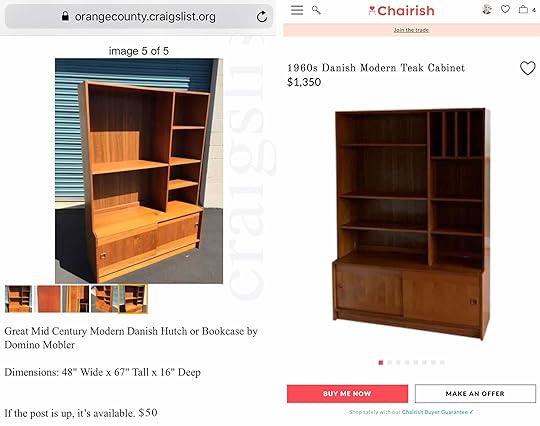 To the left is the Domino Mobler bookcase I scooped by off Craigslist for $50; to the right is a VERY similar one for $1,300 MORE…
To the left is the Domino Mobler bookcase I scooped by off Craigslist for $50; to the right is a VERY similar one for $1,300 MORE…“Include nearby areas” opens up a whole world (both literally and metaphorically). I recently found a $1,300 Domino Mobler hutch on sale for $50. You know why? It was located in Pomona (not far from me) but had accidentally been listed in Orange County (very far from me). Granted, I did not actually sell it for $1,350; I offloaded it for $400, but I’ll explain why if you keep reading.
Once you have these parameters in place, SETTLE IN! Pour yourself a glass of wine and get cozy, you’re about to get REAL in the weeds. It’s time-consuming but worth it.
Tip 2: Dumb it WAY down. When it comes to the hunt, I need you to remember that pivotal scene in Legally Blonde when Elle asks Warner what kind of shoes she’s wearing and he responds with, “uhhhh…black ones?” That’s your new thought process. Like, yes, it’d be incredible to type in “Milo Baughman” and find a smattering of $20 pieces…but people who know what they have tend to price accordingly. Your sweet spot will be the vague listings. Some of my greatest finds have been this Baughman bar cart listed as “metal table on wheels,” a burl dresser listed as a “wood closet,” a 1970s chaise listed as a “settee chair,” and a beveled lucite coffee table listed solely as “plexiglass.” So, yes, dumb it down and think about the most basic ways to describe what you’re looking for.
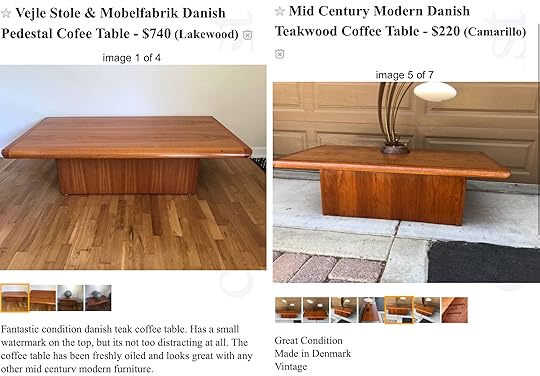 Exhibit A to the left is a seller who knew what they had. Exhibit B to the right is someone who just figured it was “mid-century” and selling their piece for 1/3 the price.
Exhibit A to the left is a seller who knew what they had. Exhibit B to the right is someone who just figured it was “mid-century” and selling their piece for 1/3 the price.Tip 3: Try alternate words and descriptions. My best-performing terms in LA are “armoire,” “hutch,” and “buffet.” True to form, I’d say that about 60% of the listings are appropriately titled and the rest are dressers, bookcases, and credenzas, respectively.
Tip 4: Try HORRIBLE SPELLING. This one is actually from Emily, but it’s real. People do NOT KNOW how to spell (especially if English is not their first language…sometimes even if it is) so try slightly changing the spelling. Great example? Dinning table. That’s right, not dining table with one “n”, but dinning. Add a few extra letters, a random “e” thrown in. You’ll be surprised what you dig up.
Tip 5: Go bilingual. Search in Spanish (or any other language that’s spoken near you). Pop over to Google Translate and figure out your basic keywords—“vestidor” is a favorite of mine (so many good dressers)!
Tip 6: Search by function. “Rolling” and “swivel” are personal favorites and deliver everything from chairs to carts to lamps.
Tip 7: Remember your apostrophes. Because even though it’s 2019, somehow the terms “80s,” “80’s,” “1980,” and “1980s” all produce different results. (Can you tell I do this search every day? For what it’s worth, when you get into decade searches, you may want to restrict yourself just to the furniture section.)
Tip 8: Break out the color wheel. If you’re on the hunt for a piece that fits in with existing decor, time to break out that thesaurus. “Blue,” “navy,” “turquoise,” “cerulean”…it’s like a treasure hunt and your goal is to find the weird post that no one else has seen. (This tip can also apply to materials—if you’re on the hunt for a lucite piece, try “clear,” “acrylic,” and “plexiglass.”)
And now that you’re a Craigslist pro, a few other things to note:
These tips work just as well on Facebook Marketplace, Letgo, and OfferUp.
If your local thrift store posts inventory on Instagram, turn on your post and story notifications. Fun fact: I have an entirely separate IG account that just follows local vendors. It comes in handy when you’re sourcing for a specific person (a point we’re about to get into!) AND you can get first dibs on some crazy deals. (And a localized tip for my fellow LA residents: turn on your post notifications for @sonofavet_thriftshop_la_. Sometimes you’ll swipe on a notification and find an ancient Dinosaurs VHS. But sometimes, it’s a $100 13′ semi-circle sofa that is now being sold for $3,000—not a typo—at a beautiful vintage furniture store downtown.) Turn on those notifications, people.
Set your budget. It doesn’t matter how much profit you can turn if you go into debt with your purchasing.
Be mindful about negotiation. My most commonly used phrase (both online and in-person at the flea market or vintage store!) is, “do you have any wiggle room?” Jumping in and offering a price 10-20% less than what someone’s asking can often be insulting, especially if there’s a lot of interest. Ask and let your vendor come down in price first—shockingly, you can respectfully still negotiate the price down from there. My follow-up go-to: “Thank you so much for trying to work with me. I LOVE this piece but only have X amount budgeted. I’m happy to pay cash and pick up ASAP.” This is by far my most successful negotiating tactic.
But on the subject of pickup, think about transport. This is the trickiest one for me (and my aforementioned Subaru Legacy, which is unfortunately NOT AWESOME for hauling large pieces of furniture). Y’all, renting a car or hiring someone to move things can cost a lot. Keep this in mind when you stumble on something huge, like an armoire.
I’m going to use the topic of transit to segue into the next section…
 Obviously, Emily’s living room but with lots of small things I think would def move well.
Obviously, Emily’s living room but with lots of small things I think would def move well.What Sells Best (& What to Avoid)…From Experience
Best-sellers
It logically follows that your best-sellers are going to be things that people can fit in their own cars. Pretty simple, right? Kinda. Your best bet for online sales on platforms like Craigslist, Marketplace, retail apps, etc. will be things like coffee tables, end tables, nightstands, dining chairs, and lamps. (For those with the itch to source things a little larger…don’t worry, I’ll get to you.)
Less-sellers
Meanwhile, smalls—our EHD-term for decor and ephemera—can be a little trickier. If you’re down to put in the effort to brand yourself with a great Instagram (I’m not, but some incredible examples of people who have done this include @oddeyenyc and @abigailbellvintage, both in NYC), you can move some well-curated decor products.
But also, buy SMART. Take a look at what’s moving in your local market. In LA, it’s currently fairly easy to turn over postmodern and mid-century pieces. (A favorite Rose Bowl vendor of mine recently joked with me that “everything with tapered legs isn’t good, but everything with tapered legs somehow sells.”) It’s WAY HARDER—at least for me, since I only sell online and never put effort into any branded distribution efforts—to move anything rustic, faux-finished, or “whimsy-patinaed.” The latter is the descriptive term I just invented for an ancient, paint-chipped book-shaped end table that I bought years ago and literally have never been able to sell. It sits in my apartment and taunts me.
Today, with my newfound knowledge, I would have stalked my local vintage vendors’ Instagram accounts so I could see the items that turn over quickly. I would have limited my buying to things that I know I could move, not things that only one person in a thousand will like. It’s HARD to find these types of niche buyers if you don’t have time to put effort into actually like, marketing yourself like a real business. So basically, if you’re starting from scratch, stick to things that appeal to a lot of people, things that you (or your future customers) can move solo, and things that fit comfortably in a sedan. Additional benefit: this takes up less real estate in your house. At my prime, I had filled up my garage and was parking my car on the street…until I discovered the method that actually made my hobby sustainable. I’m about to share my ultimate secret…
How to Actually Sell What You Bought (& It’s Not What You Think)
Here’s my ultimate secret: I realized that anyone can become a picker.
Pickers are basically the middlemen: you do the sourcing and you let the seasoned professionals with established customer bases do the selling. Let’s use the aforementioned semi-circular sofa as an example (and these are real numbers!):
Son of a Vet posts this sofa for $99.99 on their Instagram feed.
A picker sees it, sends a photo to the high-end vintage furniture store, and asks if the owner would be interested in buying the piece.
The vintage store owner says yes and offers $400.
The picker arranges transport straight from the thrift store to the high-end store and pockets 300 bucks.
Since the vintage store has “cred” and a bevy of pre-existing customers, they’re able to offer the piece at $3,000—an amount that the picker would have never been able to command on their own. (This is a similar scenario to the Domino Mobler bookcase from earlier, which is why I sold it for so much less than I knew it was worth, but still profited $350.)
The catch: you have to be social. Now’s the time to slide into the DMs (or like, approach in person, if you’re the type to actually leave your house…I’m not.), tell your local vintage/antique store that you have a few pieces that you’re looking to sell, and see if you can get an offer. Once you’ve established a relationship, you’ll have an open line of communication to send pics of your finds ALL. THE. TIME.
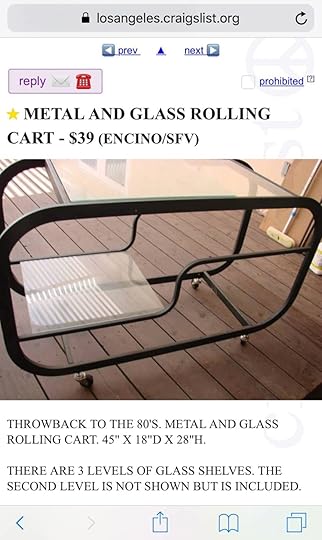 Something this price would be a great “picker” piece to sell for double to a vendor.
Something this price would be a great “picker” piece to sell for double to a vendor.Picking is the ultimate lazy dream life. You know a really fun way to spend a Sunday afternoon? Coalesce with your couch, fire up Craigslist (using my aforementioned tips, duh), and send pictures straight from listings to your new network. Not everyone will be a bite, but guess what? If you get an offer from a store, you’ll have guaranteed a sale BEFORE YOU PUT ANY MONEY DOWN. AND you won’t even have to store it.
This is a great solution for anyone who has a gift for finding the big stuff, like bookcases or credenzas. While it never made sense for me to hire someone to move furniture from a sale site to my house to a final destination it DID often make financial sense when I was moving something straight to a store. My philosophy: I don’t need to sell it for the most, I just need to sell it. I kind of like that in my scenario, three people (the original seller, me, and the final retailer) all get to turn a profit off of a sustainable product.
But what if I don’t HAVE any vintage furniture retailers near me? Don’t worry because there’s an avenue for you, too, and it involves your friends and family. Ask around and see if anyone in your network is looking for any pieces, either furniture or decor, and clarify if they have a budget they’re trying to stay within. I’m sure you know what to do from here…it’s sourcing time. When you have the internet sleuthing skills that I’ve hopefully helped hone, finding pieces for friends can be EASY. Shoot them a pic, confirm a price (that builds in a little profit margin for your efforts), and again, you’ve managed to confirm a sale without any upfront investment.
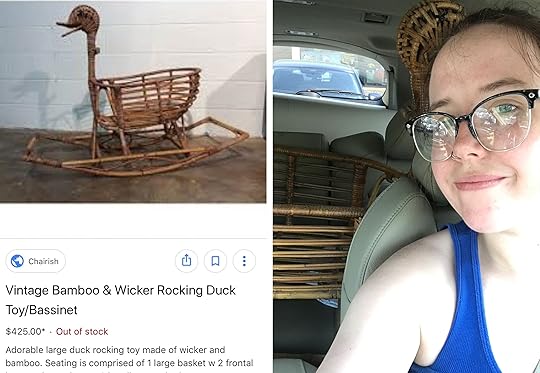 Picking in action. A vintage bamboo rocking DUCK bassinet (please don’t put your baby in this) sold on Chairish for $425. I sourced the one in the car seat behind me for $20. Full discloser: I did not sell this to Chairish, but I was able to use that listing to know what this thing could go for and priced accordingly.
Picking in action. A vintage bamboo rocking DUCK bassinet (please don’t put your baby in this) sold on Chairish for $425. I sourced the one in the car seat behind me for $20. Full discloser: I did not sell this to Chairish, but I was able to use that listing to know what this thing could go for and priced accordingly.If you’re the refinishing/repainting/repairing type, I salute you. If you’re the “up at 3 am to style out my flea market booth” type, I salute you. If you’re the “I solely sell online and I’ve built out my own customer base” type, I salute you. But if you’re the “I just love home goods and would probably spend my free time cruising Craigslist for furniture anyway, so I may as well figure out how to monetize it while I sit on my couch with a glass of wine while The Office plays in the background” type…this is a side hustle for you.
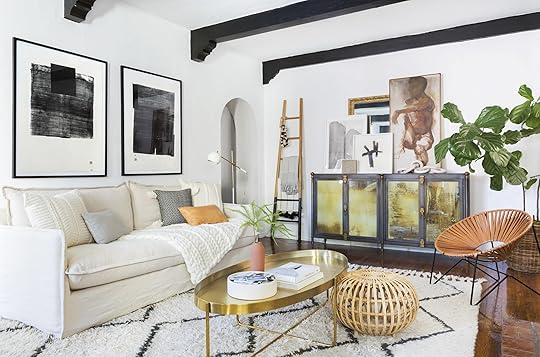 Again, not my actual goods. Had I known I’d be writing this post years later, I would have hoarded images, but in the off chance you don’t know what a Beni Ourain rug is, it looks like this one from Brady’s living room.
Again, not my actual goods. Had I known I’d be writing this post years later, I would have hoarded images, but in the off chance you don’t know what a Beni Ourain rug is, it looks like this one from Brady’s living room.BONUS STRATEGY: The Dropshipper
Here’s a bonus that I won’t dive too much into, but it is how I got my start in the world of furniture and decor retail…
In 2015, I was PINING after a vintage Beni Ourain rug, but I couldn’t afford it. Long story short, I found my dream carpet online from a shop in Marrakech and realized that you can barter online (Like, what?! Why didn’t anyone tell me this before?! A LIFE CHANGING TIP!) and ended up negotiating the price down by nearly 50%. After securing a few rugs for friends at similar prices, my vendor asked if I’d like to lock in wholesale pricing and started sending pictures of his incoming inventory. I’d list these rugs on Craigslist, Etsy, Chairish, Letgo, Offerup, etc. with his photos, detailed dimensions, and keywords.
When a rug seemed like it would sell or if I’d locked in a buyer, I’d make the purchase and have him send the rug over so I could complete the sale (or, in Etsy/Chairish customers’ cases, I’d have him send the rug straight to their home!).
I’d pay anywhere between $250-$600 per carpet (which included customs and shipping and trust me, this was an INCREDIBLE STEAL at the time) and I’d retail each for anywhere between $400 and $1,200. Shockingly, I don’t have any horror stories to report—rugs arrived in one piece, on time, and were always as pictured. Only once did I have a buyer back out after I had purchased from my vendor…but it was okay, because I really liked the rug and ended up keeping it. C’est la vie.
Carpets had incredible margins, but I did get tired of playing middleman across the ocean AND offering things up nationwide. It takes time and effort to post listings, communicate with potential buyers, clarify questions with vendors, and honestly, I realized I just had more fun looking for vintage furniture. I sold my last rug in 2017, but let’s be real: the hustler in me is still always down to source for a friend.
WOW. You made it. If you can’t tell, I’m a big fan of any hustling that can be done while I’m wearing pajamas…and apparently, I can talk about vintage furniture ALL. DANG. DAY. Perhaps this job is the right one for me. I’ve spent a long time optimizing this for my own work style, but would obviously love any of your flipping tips. Are you a refinisher or a picker? What does your side hustle look like? Any pro tips I missed? Sound off in the comments, please. I’d love to hear more about your scores or horror tales… 
Emily Henderson's Blog
- Emily Henderson's profile
- 10 followers



